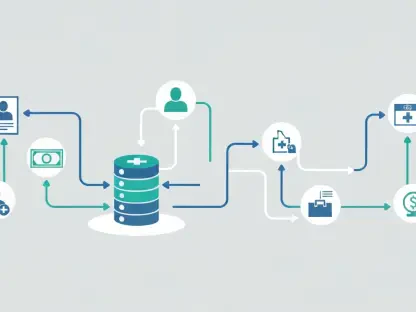In today’s rapidly evolving digital landscape, establishing resilient security frameworks has become an urgent necessity for organizations worldwide. The alarming increase in cyber threats, particularly within cloud environments, underscores the need for robust defenses to navigate the ever-changing and sophisticated cyber threat environment. Drawing from insights provided by Nikhil Chandrashekar, a distinguished leader in data security and backend engineering, this article delves into the importance of secure software design, data protection, and advanced authentication protocols while exploring emerging cyber threats and best practices for fortifying organizational security.
The Rising Tide of Cyber Threats
Alarming Statistics and Trends
Recent statistics reflect a significant rise in cloud environment breaches and identity attacks. Over the past year, incidents within cloud environments surged by 75%, with cases related to cloud security climbing by 110%. Additionally, there has been a 76% increase in individuals mentioned on eCrime leak platforms. Such numbers illuminate the rapidly changing landscape of cyber threats as cybercriminals grow more adept. Among identity attacks in 2023, 75% were due to non-malware activities such as phishing, social engineering, and the exploitation of trusted relationships. This is a stark contrast to 62% in 2021 and only 40% in 2019. This trend indicates that threats are not only increasing but also evolving in complexity and sophistication, demanding proactive and resilient security measures by organizations.
Vulnerabilities in Cloud Environments
Nikhil Chandrashekar emphasizes the necessity of staying ahead of these evolving threats. He points out that cloud environments are particularly vulnerable, with 84% of breaches attributed to likely eCrime actors, as opposed to just 16% from targeted intrusions. This shift in the threat landscape necessitates a complete reevaluation of current security frameworks and the implementation of more robust and adaptive strategies. Failure to adapt and respond to these changing threats effectively can lead to significant security breaches, causing not just financial loss but also potentially irreparable reputational damage. Thus, organizations must prioritize enhancing their cloud security measures to defend against such increasing and sophisticated threats.
Emerging Threats and Technological Advancements
New Entry Points and Generative AI
As we navigate through 2024, new types of devices, such as edge gateway devices used to connect disparate networks, are becoming favored entry points for attackers seeking unnoticed access. These devices can be particularly vulnerable due to often limited security features, making them attractive targets for cybercriminals. Additionally, the emergence of generative AI technology is anticipated to have a substantial impact on cyber activities moving into 2025. Nikhil explains that as technology progresses, so do the tactics employed by cybercriminals. For instance, while there has been a 15% year-over-year reduction in spam emails, this does not indicate a decrease in threats. Instead, it reflects attackers adopting more advanced techniques that necessitate continuous vigilance and adaptable security measures.
The Role of Artificial Intelligence
Artificial intelligence (AI) is playing an increasingly pivotal role in combating cyber threats. A recent survey indicated that 35% of Chief Information Security Officers (CISOs) are currently utilizing AI for security applications, with 61% planning to adopt it within the next year. Moreover, 86% of CISOs believe that generative AI can help bridge security skills gaps and alleviate talent shortages. Nikhil notes that AI can enhance the ability to detect and respond to threats more efficiently. However, it is crucial to educate teams about the risks associated with generative AI, with 39% of CISOs intending to focus on this training. By leveraging AI, organizations can significantly improve their defense mechanisms, yet the human element remains critical in ensuring effective implementation and risk assessment.
Challenges Faced by CISOs
Pressures and Responsibilities
Despite the potential benefits of AI, CISOs face considerable challenges in their roles. An overwhelming 82% would contemplate whistleblowing if their organization blatantly ignored security and compliance issues, putting the organization at risk. This dilemma underscores the enormous pressure CISOs face in safeguarding their organizations from cyber threats. Additionally, 84% express concern about personal liability regarding cybersecurity incidents, potentially exposing them to significant risks personally and professionally. Nikhil remarks that CISOs are under intense pressure to ensure their organizations are protected against cyber threats. Unfortunately, only 35% report that their boards allocate sufficient budgets for cybersecurity, leading to delays or even cancellations of essential security initiatives. Such underinvestment hampers their ability to respond effectively to evolving threats.
The Persistent Threat of Malware
Malware remains a significant threat, with 5.4 billion malware attacks recorded worldwide in 2022, 40% of which resulted in unauthorized exposure of sensitive data. Over 70% of these attacks target specific individuals or organizations, with threat actors executing an average of 11.5 attacks every minute. Parachute data reveals that 92% of malware is delivered via email, underscoring the necessity for organizations to implement effective email security protocols. The most prevalent malware variant in 2022 was the VBA Trojan, and Iran experienced the highest rate of mobile malware attacks, while the United States faced malware incidents at a rate nine times greater than the United Kingdom. Spyware is the most common type of malware directed at individual users, and approximately 70% of organizations report that their users are served malware-laden advertisements in their browsers, highlighting the persistent nature of this threat.
Best Practices for Building Resilient Security Frameworks
Regular Security Audits and Employee Training
To develop strong security systems, Nikhil emphasizes several key practices. Regular security audits are essential for uncovering and addressing vulnerabilities. These audits help organizations identify potential weaknesses and assess their defense mechanisms comprehensively. Equally important is fostering a culture of security awareness through employee training programs focused on secure coding techniques and the critical role of authentication protocols. Training employees ensures everyone within the organization understands their role in maintaining security and can identify potential threats. Leveraging cutting-edge technologies like AI and machine learning helps detect and respond to threats with speed and precision, enhancing the overall security landscape.
Implementing Robust Email Security Measures
In the fast-paced world of digital technology, building strong security frameworks has become a critical priority for organizations on a global scale. The dramatic rise in cyber threats, especially in cloud computing environments, highlights the urgent need for formidable defenses to withstand the continuously evolving and sophisticated nature of cyber attacks. With insights from Nikhil Chandrashekar, a renowned expert in data security and backend engineering, this article examines the critical aspects of secure software design, robust data protection measures, and advanced authentication protocols. Simultaneously, it explores the latest cyber threats and outlines best practices for enhancing organizational security. By understanding the importance of these elements, organizations can better shield themselves against potential breaches, ensuring data integrity and confidentiality. Adopting best practices and keeping abreast of emerging threats are essential steps in building a resilient defense system that can adapt to new cyber challenges.









